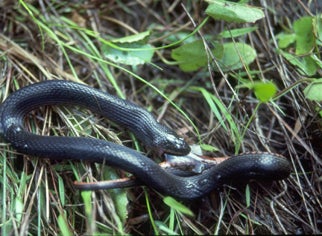SCIENTIFIC NAME:
Regina pygaea pygaea (Cope),
OTHER NAMES:
Black Swamp Snake, North Florida Black Swamp Snake, Swamp Snake.
STATUS:
Peripheral and rare in extreme southern Coastal Plain. Known from 3 Covington County localities and one locality west of Conecuh River in Escambia County that represents the northwestern limit of the known United States' distribution. MODERATE CONSERVATION CONCERN.
DESCRIPTION:
A small (25.4-38 cm [10-15 in.] long; largest individuals approx. 47 cm [18.5 in.]) aquatic snake with a shiny, black back and red belly. Scales shiny and smooth; lower scale rows with a faint, longitudinal line, giving the appearance of keeled scales. Belly has black square blotches infused peripherally between the red, ventral scales. Eye color difficult to distinguish from black head. Head only slightly distinct from neck. Scales underneath head yellow to pink. Anal scale divided. Younger individuals similar to adults. Females generally longer and weigh more than males. Although has relatively short tail compared with other snakes, males have longer tails than females. The three subspecies of black swamp snake delineated by the number of ventral scales (Dowling 1950).
DISTRIBUTION:
Confined to southern Georgia, extreme southern Alabama, and northern Florida. In Alabama, only known from three localities in Covington County (Mount 1975) and one in Escambia County west of Conecuh River (Bailey 1987). Other subspecies in the Carolinas and southern Florida.
HABITAT:
Canals, ditches, cypress ponds, lakes, and swamps, especially those with lush vegetation. Collected from ponds by pulling dense aquatic vegetation on to shore, or by inspecting under boards and debris near the edges of ponds. Opportunistically observed on rainy nights along roads near swampy environs (Martof et al. 1980).
LIFE HISTORY AND ECOLOGY:.
Although active every month of year, most active during summer. From two to 11 young born alive in late summer or early fall (Seigel et al. 1995). Development may occur in ephemeral ponds (Dodd 1993). During winter months, burrows into bottom vegetation or sphagnum moss. In the wild, preys mostly at night on earthworms, leeches, arthropods, small fishes, and small amphibians.
BASIS FOR STATUS CLASSIFICATION:
Infrequently encountered in Alabama, because it is either rare, secretive, or both. Population levels in Alabama unknown.
Authors:
Mark H. Hughes and Mark Bailey






